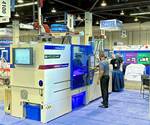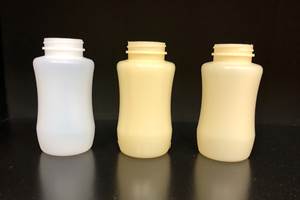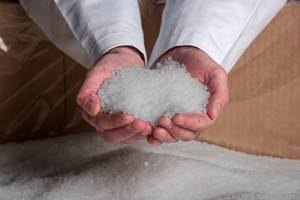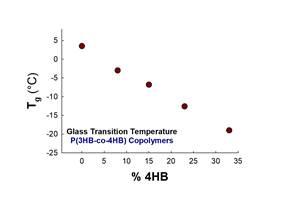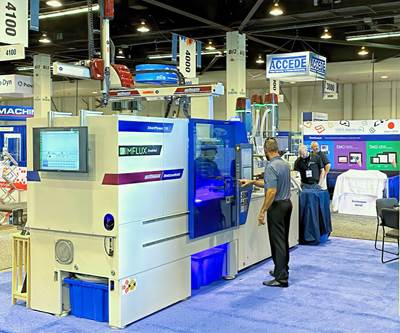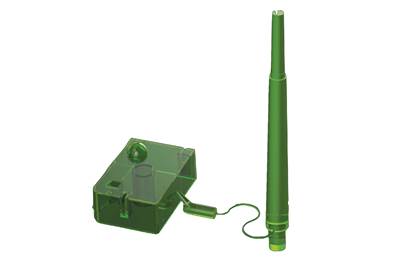
Should we expend so much time, energy and expense in trying to make PCR process like virgin resin – with limited success? Or, the author proposes, we could accelerate plastics recycling more cost-effectively by adopting technologies designed to accommodate and correct for the inherent variability of PCR. (Images: iMFLUX)
Albert Einstein once said, “We cannot solve our problems with the same thinking we used when we created them.” This, however, is exactly what the plastics industry is doing when it comes to running post-consumer-recycled (PCR) materials. We are trying to solve the problem of material variation with the same thinking that created the problem. We are developing a recycling infrastructure designed to deliver narrow viscosity variation, which leads to unnecessary complexity, higher material cost and loss of material integrity – and is only marginally effective.
My question to you, and the industry as a whole: Are we addressing the issue the right way? In my opinion, no. Instead of trying to narrow or eliminate variation, the right approach is to embrace technology that will allow running PCR materials with widely varying viscosity. This will greatly simplify the recycling infrastructure and processes, will make it more cost-effective, and will accelerate the transition to a circular economy. This article focuses on injection molding, but I believe the same basic principles apply across most if not all of plastics processing.
This is not new thinking. We embrace variation in our lives every single day and we innovate to manage that variation. The modern automobile, for example, manages variation in road conditions, the actions of other drivers, and even weather conditions. We now have cars that assist you to maintain your lane, avoid hitting the car in front of you, stop the car before you back over your neighbor’s child, and perform tough tasks like parallel parking or backing up a trailer. Soon we will have fully autonomous driving vehicles. In our homes we manage temperature, lighting, sound, airflow, and even the smell of the place. We embrace and even enjoy the inherent variations in our living environment.
“We are developing a recycling infrastructure designed to deliver narrow viscosity variation, which leads to unnecessary complexity, higher material cost and loss of material integrity – and is only marginally effective.”
In an injection molding operation we manage many types of variation as well. We manage humidity with dryers, environmental temperature variation with HVAC systems, cooling water with chillers and TCUs, cavity-to-cavity variation with hot-runner and mold designs, and shot-to-shot machine performance with sensors in the machine and mold. For plastic resins, however, we don’t manage viscosity variation. Instead, we ask the resin supplier to control variation to a minimum level. In fact, we spend extra money to buy materials that vary as little as possible because this leads to more stable processes. Why?
For the past 30+ years we have accepted an approach to processing plastics that cannot handle viscosity variation, and even relatively small variations can lead to bad part quality. While this has worked reasonably well for many years with virgin materials – since feedstock can be closely managed and polymer manufacturing processes have been perfected over time – we no longer have those luxuries as we transition to running PCR. We will need innovation designed to manage viscosity variation.
FIG 1 Samples of eight typical injection molding grades of recycled PP found that MFI within a sample varied by ±24% on average, far more than most injection processes are designed for.
How Much Do PCR Materials Vary & Why?
We recently took a snapshot of eight typical injection molding grades of recycled polypropylene (rPP), and found viscosity (MFI) varied ±24% on average – a 20 MFI material, for example, would range from about 15 to about 25 – far more than most processes are designed to run (Fig. 1). These samples included rPP produced by both mechanical and solvent-based recycling methods and were high-grade specifications that would typically be used for precision-molded products. In other words, these were highly curated recycled resins designed to minimize variation – yet they still varied widely.
PCR varies widely in MFI because the plastics we recycle vary widely. To demonstrate this we randomly tested 50 injection molded PP parts from the grocery store. Their MFI ranged from about 3 to about 100 with an average of about 20 (Fig. 2). The wide range of MFI is driven by the way we injection mold plastics – the decoupled molding process – whereby we fill by velocity and then transfer to a packing or holding pressure (Fig. 3). This method requires a lower-MFI material when a part is easy to fill and a higher MFI when a part is hard to fill. Since this approach is very sensitive to even small shifts in viscosity, many MFI specifications are needed to run the wide range of part designs we create. This wide range of MFI material then becomes feedstock for recycling, and it then becomes the recycler’s job to segment these materials into a manageable range of MFI specifications.

FIG 2 A visit to a supermarket yielded 50 injection molded parts whose MFI ranged from around 3 to about 100 with an average of about 20.
Recyclers work hard to remove variation, with limited success as noted above, despite extensive efforts to carefully identify supply sources, elaborate strategies to test/segment/blend material streams, big investments in sorting and separation technology, using additives to modify viscosity and properties, and even reprocessing multiple times to achieve the desired result. These steps are complex, expensive, require high energy use, and in many cases damage the integrity of the polymer. We have a choice: We can continue to pour resources, time, and money into technology that is marginally effective at reducing MFI variation, or we can embrace proven technology that can efficiently run variable-viscosity materials. I think the choice is easy – let’s stop over-complicating the recycling infrastructure; let’s accelerate our transition to running PCR with processing technology designed to manage material variation.

FIG 3 Conventional decoupled molding fills by velocity and then transfers to a packing or holding pressure. This produces a high-pressure spike and requires a narrow viscosity range to maintain consistent part quality.
We can efficiently manage MFI variation
There is a way to efficiently manage MFI variation and make consistent-quality parts. The solution is to adapt automatically to viscosity changes as they occur. The injection machinery OEMs are developing adaptive processing technologies for the decoupled molding process that index transfer, velocity and packing pressures to compensate for viscosity changes. These technologies are highly effective, but the complex interactions between decoupled control parameters make it challenging to compensate for wide viscosity shifts, like we see in PCR.
Since conventional molding is very sensitive to even small shifts in viscosity, many MFI specifications are needed to run the wide range of part designs.
At iMFLUX, we offer an alternative processing technology that uses low, constant pressure, and an auto-viscosity-adjust (AVA) feature that automatically adapts to viscosity changes (Fig. 4). The Green Curve, as we call it, fills the mold with a single constant-plastic-pressure phase – there is no clumsy transfer from fill to hold; there is no high-pressure spike; there are fewer complex interactions between processing variables. This simplified approach enables our AVA feature to measure and adapt to viscosity changes in real time, even with extreme shifts in viscosity. It is a “universal” process that is agnostic to material viscosity changes. Most major machine makers offer an iMFLUX solution on new and used electric, hydraulic and hybrid machines.

FIG 4 The iMFLUX “Green Curve” works by filling and packing the mold in one step, using a low and constant plastic pressure. The heart of the process is a proprietary control system that eliminates flow hesitations, packs the part as it fills, and reduces pressure loss within the mold. This allows plastic to flow much slower than in conventional processing techniques and results in lower pressure, faster cycles and the ability to adapt in real time as molding conditions (like viscosity) vary. Advantages include improved OEE, greater material selection flexibility, improved quality, ability to reduce tonnage, lightweighting and flexibility in running sustainable materials – especially highly variable recycled materials.
The examples in the accompanying table illustrate how effective the iMFLUX technology in adapting to a large viscosity shift, while also maintaining consistent part quality. In these examples a complete material transition is made quickly over a period of six to 10 shots, which would generally lead to shorts, flash, dimensional and/or aesthetic issues with standard processing technology.
Confronting the Challenge
Confronting the PCR challenge is not easy. Changing our thinking, adopting new technology, collaborating across major stakeholders to build critical mass behind new solutions are definitely not easy. It is my hope that this one change in thinking – the need to embrace variation rather than fearing it – is something the industry can rally behind. In my view, this is one of the most important enablers to a circular future for plastics, and for the injection molding industry it is within reach if we act now.
The world is counting on us to move quickly to find innovative solutions that deliver true circularity. The consumer wants to know that when a plastic part is recycled, it will be transformed to an equal or higher purpose – efficiently, affordably, and as many times as possible. They do not want just more PCR park benches or flower pots – they want precision packaging, medical devices, appliances, automotive parts – they want recycled plastic parts that make their everyday lives better. We need to offer solutions that make plastics not just a good choice, but a superior choice when it comes to environmental impact.
We are at a critical juncture. As we build recycling infrastructure, we have a chance to minimize complexity, reduce capital cost and accelerate scaling in all phases of the supply chain. If we act now, we can realize this simplification – fewer material specifications, increased available supply, and lower material costs. If we wait, we will be stuck with a recycling infrastructure designed to deliver the complexity we created over the past 30+ years.
The implications are big: If we choose to pursue narrow-viscosity materials, the added complexity will slow our transition and add cost. If we choose to embrace wider-viscosity materials, we can transition faster and reduce material cost. For perspective, if we avoid adding just 10¢/lb in costs to the supply chain, this equates to $100,000 in annual savings for a typical 500-ton molding line; an average factory would save about $20 million annually; industry-wide, the savings would be tens of billions per year.
The quality-management guru W. Edwards Deming once said, “You don’t need to change – your survival is not mandatory.” As a plastics industry, we are in a battle for survival, so let’s join forces to make the needed changes.
ABOUT THE AUTHOR
Gene Altonen has been the chief technology officer of iMFLUX in Hamilton, Ohio, since 2015. He is the inventor of the iMFLUX core technology, and leads the iMFLUX R&D organization. Gene has spent his entire 30-year Procter & Gamble career developing new packaging solutions, including numerous injection molding technology innovations. Prior to the iMFLUX launch, Gene was a P&G Research Fellow, leading major technology developments in the company’s Injection Molding Capability organization. He holds more than 50 patents and has at least 35 patent applications pending. For more information about iMFLUX, contact 513-973-2042; info@imflux.com; imflux.com.
Related Content
NPE2024 Wrap-Up: Sustainability Dominates Show Floor News
Across all process types, sustainability was a big theme at NPE2024. But there was plenty to see in automation and artificial intelligence as well.
Read MoreHow to Extrusion Blow Mold PHA/PLA Blends
You need to pay attention to the inherent characteristics of biopolymers PHA/PLA materials when setting process parameters to realize better and more consistent outcomes.
Read More‘Monomaterial’ Trend in Packaging and Beyond Will Only Thrive
In terms of sustainability measures, monomaterial structures are already making good headway and will evolve even further.
Read MoreFilm Extrusion: Boost Mechanical Properties and Rate of Composting by Blending Amorphous PHA into PLA
A unique amorphous PHA has been shown to enhance the mechanical performance and accelerate the biodegradation of other compostable polymers PLA in blown film.
Read MoreRead Next
Low-Pressure Injection Process Facilitates ‘Green Molding’
Besides speed and quality advantages, the low-pressure iMFLUX process is said to enhance sustainability—easing use of recycled and biobased materials, saving energy, reducing scrap, and adding lightweighting potential. See what molders say about these “green” benefits.
Read MoreHow to Mold This ‘Impossible’ Part
New low-pressure injection molding process “breaks the rules” and solves difficult molding problems.
Read MoreMoving Toward ‘Autonomous Molding’ with a Uniform-Low-Pressure Process
A new low-pressure injection molding process has aroused interest among molders and machine suppliers. In his second article on iMFLUX, the inventor of the process explains how it is evolving to support the overall industry goal of self-correcting molding processes that can compensate for common causes of variation to maintain consistent part quality.
Read More

